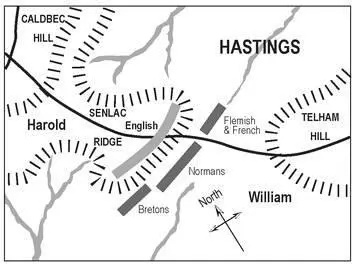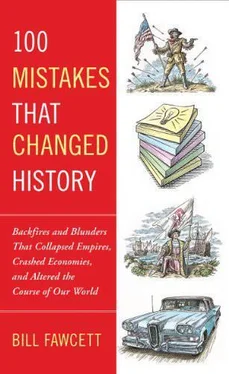Toward the end of Edward’s reign, the country began a downward spiral as the different factions fought among themselves. The Anglo-Danish council, who believed they spoke for the entire populace, weakened the power of the monarchy without strengthening their own administrative body. Local chieftains began intriguing and pursuing their own interests, and feuds broke out all over the country. In this chaos and uncertainty, Edward took to his deathbed. With his last breath, he allegedly named Harold as his successor, despite having already promised it to William, the duke of Normandy. Conveniently, Archbishop Stigand, a staunch supporter of Earl Godwin, had been present to confirm the announcement. Edward the Confessor died in January 1066. (The Church later canonized him and he became England’s foremost saint until replaced by St. George.) Disregarding the oath he took at William’s court and the fact that he had no hereditary claim, Harold took over as king. Things quickly got complicated. Much of England accepted Harold as their king, but the royal houses of Europe and the Church in Rome did not. In William’s eyes, it became his duty to overthrow the usurper. So, he crossed the Channel and with a little help from Harold defeated the Saxons.
In a Hurry to Lose
1066
Harold Godwinson, king of England, had something to prove. Edward the Confessor had died without having an heir. So the Witan, a council of nobles, named Harold king. He was not a unanimous choice and could not claim that he had a divine right to the throne. The closest he got to royal blood was that Edward had been his brother-in-law. To many, this meant that the rule of England was theirs and was available for the taking. Two men decided to do just that.
Harold’s brother, Tostig, also claimed the throne. If Harold’s blood was good enough to be that of a king, so was his brother’s. To support his claim, Tostig turned to an old enemy of England, Harald Hardrada, the Viking king of Norway. In Normandy, another man had reason to claim the throne of England as well. This was William, duke of Normandy. William, through persuasion and politics, managed to get Pope Alexander II to support his claim. In a religious age, this made recruiting knights and soldiers easier and guaranteed support of the clergy. Both were needed to invade the island and enforce one’s claim.
Tostig and Harald landed first near modern-day York. The new English king hurried north accompanied by his huscarls— ax- and shield-wielding warriors sworn to his service—the only professional soldiers he commanded. The king gathered further fighters from the local militia, the fyrd , until his army matched that of the Vikings in size if not quality. After marching 200 miles in five days, Harold was able to surprise the normally canny Norwegian king and Tostig at the Battle of Stamford Bridge. It was September 25, and the battle was a tough and costly fight, with Harold Godwinson losing nearly 1,000 dead or wounded huscarls, cutting his personal guard and the island’s only full-time military force by a third.
Just a few days later, on October 1, Harold got word that William of Normandy had landed his army near Hastings. The southern fyrd had already been called up, so it was ready to join up with him and his huscarls. But Hastings was more than 300 miles away from York. Having exhausted his army in the march north, the English leader now had to make a decision. If he did not react quickly, William the Norman would be able to establish a strong position. This would be particularly true if William captured a few cities. But perhaps another thought lay behind the new king’s mistake, one that may have cost him and the Saxons England. Elected without royal blood, Harold had to show everyone that he was capable of defending England and worthy of being the first of a new line of Saxon kings. To do that, he may have felt it necessary to act before William could do much damage to what was one of the richest parts of his kingdom.
For whatever reason, Harold not only began moving south but hurried toward Hastings in an even greater rush than he had gone north a week before. This had two negative effects. The speed of the march meant that many of his lightly wounded, or just plain exhausted, huscarls could not keep up. Even riding at that speed was punishing. The hurried march also meant that hundreds of fyrd and local nobles who might have joined the Saxon army were unable to do so.
When Harold arrived near Hastings he again did not pause. The Saxon king formed his army on Senlac Ridge and prepared to battle William. Even though he fought on home ground and in defense of the land, the new king’s haste meant that the two armies were of about the same size.

The Battle of Hastings
Harold and his warriors at first stood and beat back the Norman attacks. But the fyrd who were fighting on the right of the Saxon position attempted to pursue a feigned retreat, and they were ridden down by William’s mounted knights. Eventually, more than anything else, the Normans wore down and then broke the Saxons. Exhausted and outnumbered, the huscarls died fighting. Harold was hit by an arrow in one eye, and with his death, the Saxon defense collapsed. He had hurried to his death. Had Harold hesitated until he could gather a much larger army, he might have held England. William of Normandy had no reinforcements to match those Harold could have called from all over England. Harold risked everything in the hope of a quick victory that would ensure his position on England’s throne forever. But in his haste he, and the Saxons, lost everything. It is impossible to determine how much the exhaustion of his best troops, the huscarls, affected the battle. But William was able to finally break the Saxon formation and went on to become known as William the Conqueror (an improvement on his former commonly used name, William the Bastard). Harold, king of the Saxons, had rushed to defend his new throne and, in the effort, lost all of England.
The Battle of Hastings marked the end of the Saxon-Danish rule in England. It also marked the beginning of a cultural revolution. Unlike Canute, who embraced the Anglo-Saxon culture, William sought to wipe it out. He replaced the Saxon and Danish nobles with Norman nobility, he handed out land grants to his men, and he implemented Norman law. Great building projects took place all over the British Isles, and the crude dwellings of the Saxons gave way to magnificent Norman Cathedrals and castles. These changes helped establish England as a formidable power, but it was surely not the future Earl Godwin had in mind when he appointed Edward the Confessor as king. Godwin sought to make England a nation of Saxons and Danes, getting rid of the Norman influence altogether. Instead, his underhanded tactics and treatment of Edward ended up paving the road to destruction of the very culture he fought so hard to preserve and ensured that the Norman kings and not the Saxons would go down in history as the great kings of England.
King, Not Country
1086
In 1186, the land of Outremer was thriving. Outremer in French translates basically to “across the seas.” The kingdom had been founded by Christian crusaders in 1098. Its income from trade was substantial. This provided the money needed to construct a strong line of castles and fortified cities that protected the kingdom of the Holy Land from the constant threat posed by Islam. In the age of great castles, those of Outremer were among the most powerful and imposing.
Читать дальше













